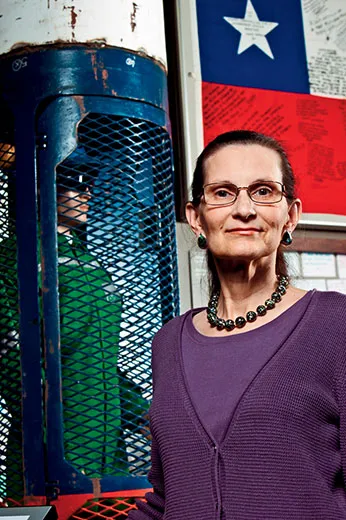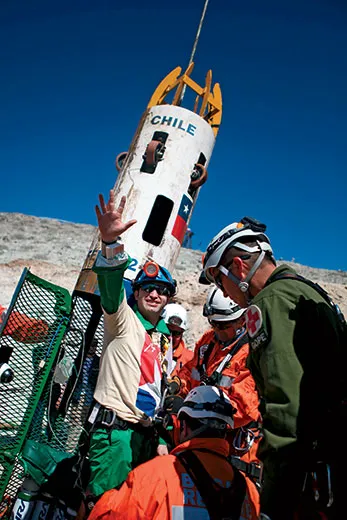The Capsule That Saved the Chilean Miners
The Natural History museum offers an inside look at the dramatic rescue of men trapped half a mile underground in a Chilean copper mine
The moment the white torpedo-shaped container finally surfaced, having been slowly pulled up the half-mile-deep rescue tunnel, people worldwide felt relief—and wonder. It was October 13, 2010, a time otherwise notable for troubling headlines and economic meltdowns, and the sight was as inspiring to some as the great NASA rocket launches of decades ago. After 69 days trapped deep in Chile’s San José copper mine, 33 miners, hauled from the depths one at a time, stepped out of the tiny capsule and into the embrace of a cheering world.
Engineers had named the custom-made capsule the Fenix 2; its twin, the Fenix 1, which the rescuers used to test the technology at the mine site, is the centerpiece of the exhibition “Against All Odds: Rescue at the Chilean Mine,” at the National Museum of Natural History (NMNH). The exhibition, which opened just before the first anniversary of the mine collapse and will remain until May, includes other relics of the operation and some mementos, such as the Bible the miners prayed with daily and the watch they used to mark the days underground. But the Fenix 1, thirteen feet tall and only 21 inches in diameter, is the most vivid reminder of just how treacherous and unlikely the rescue really was.
Looking at the capsule, Sorena Sorensen, the curator of the show and a geologist, marvels at the miners’ mental resolve in overwhelmingly bleak circumstances. “These guys were tough cookies,” she says.
The story of the disaster and rescue, Sorensen says, starts with Chile’s geologic history. The country is located where the Pacific and Nazca plates slide under South America, pushing seawater-laden rock to hotter depths and, over millions of years, generating rich deposits of copper ore. “Copper has been mined in Chile since about 500 B.C. The Incas were mining it,” says Sorensen. “The San José mine began producing copper—that is to say, someone found it and began to mine it—in the late 1800s.”
On August 5, 2010, a cave-in blocked the mine’s main shaft in two locations. Rescuers scrambled to drill exploratory holes to locate the men. “They were prospecting for people, and the boreholes were tiny,” Sorensen says, pointing to a 13-inch-wide drill bit on display. “It’s like taking a toothpick and putting it through a square yard of sandstone.” Improbably, on August 22, on the eighth exploratory drill, the bit returned to the surface with a note taped to it—“We are well in the shelter, the 33.”
The Chilean government called in NASA’s Engineering and Safety Center (NESC) to help with the rescue. The center was established after the Challenger and Columbia space shuttle disasters and has worked on a range of projects worldwide, from submarine rescues to oil spills. “We can be sent somewhere on a moment’s notice,” says NESC engineer Michael Aguilar. “It’s kind of like ‘Mission: Impossible.’ You’ve got a mission, and you put a team together.”
The engineers equipped the rescue capsule with audio and video links to communicate with each miner during the 10- to 15-minute ascent, probes to check heart rate and other functions, and an emergency oxygen supply. “We thought, ‘What if he gets stuck?’ so it has a trapdoor that can drop out the bottom and a rope coming down,” Aguilar says.
The rescuers “tested the Fenix 1, putting it down into the hole many times,” says Nicolas Bar, the cultural attaché at the Chilean Embassy, who arranged for the capsule to come to the museum. “Then they decided to use the Fenix 2 for the rescue.”
“The extras were built for the same reason that NASA builds duplicates of the stuff that is going out into space,” Sorensen says. “If it broke in some way, and you have its exact duplicate at the surface, you could look at it and see what the miners are telling you about what is going on.”
On the day of the extraction, the miners were strapped into the Fenix and hoisted upward. As each surfaced, spectators grew more and more elated. When crew foreman Luis Urzúa emerged, completing the rescue of all the miners, the crowd of onlookers cheered, and it is safe to say that millions worldwide viewing the operation on TV did, too.
“Seeing the capsule here is very moving for me,” says Bar. “This was a collaborative effort. It’s not just a national story from Chile, but an international story.”
/https://tf-cmsv2-smithsonianmag-media.s3.amazonaws.com/accounts/headshot/joseph-stromberg-240.jpg)


/https://tf-cmsv2-smithsonianmag-media.s3.amazonaws.com/accounts/headshot/joseph-stromberg-240.jpg)